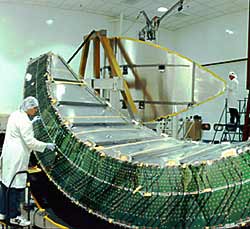Power to the Pentaquark
About Quarks
What’s inside an atom? What’s inside a proton? These are questions asked by physicists, who seek to understand matter on the most fundamental level.
An atom contains a nucleus, made up of protons and neutrons, surrounded by a cloud of electrons. Experiments that probe deeper find that electrons show no structure, but protons and the neutrons do. They contain fundamental particles called quarks, which attract each other so strongly that they cannot exist as free particles under ordinary conditions. Cosmologists theorize that in the incredible conditions right after the Big Bang, quarks could exist freely in what is called the quark-gluon plasma, a state of matter that some particle physics are trying to create in the laboratory. (See Nuclei Knockdown)
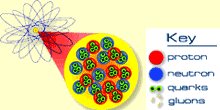
Diagram of quark structure of protons and neutrons (diagram courtesy of Brookhaven National Laboratory)
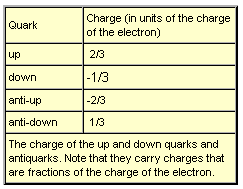
Quarks come in six evocative "flavors,"—up, down, strange, charmed, bottom, and top—and for each of these there exists an antiquark. (See The Buzz about Antimatter)
Combinations of the up and down quarks make up the nuclear particles—two up quarks and one down for the proton, and one up quark and two down for the neutron, as shown in the diagram. The charges of the quarks combine to give the charge of the proton and the neutron, as shown below and in the table.
Proton = up quark + up quark + down quark
Charge of the proton:
+1 = 2/3 + 2/3 – 1/3
Neutron = up quark + down quark + down quark
Charge of the neutron:
0 = 2/3 –1/3 – 1/3
A different kind of particle, the meson, is composed of two quarks, or, more specifically, a quark and an anti-quark. For instance, the pi-plus is an up quark and an anti-down quark. That gives us two kinds of particles made of quarks—nuclear subatomic particles (the proton and neutron) and mesons. Could there be more?
Research
According to the Standard Model, protons, neutrons, pi-mesons, and other related particles are composed of various combinations of quarks. In this theory, a particle consisting of five quarks—the pentaquark—is possible. There is an old saying in physics that “Anything not forbidden is required.” Perhaps with this in mind, physicists have been looking for the five-quark particle for 30 years. In 1997 this search received new direction with a prediction by three Russian physicists that the pentaquark consisting of two up quarks, two down quarks, and one anti-strange quark would have about 1.5 times the mass of the proton and could be detected with present-day particle physics technology.
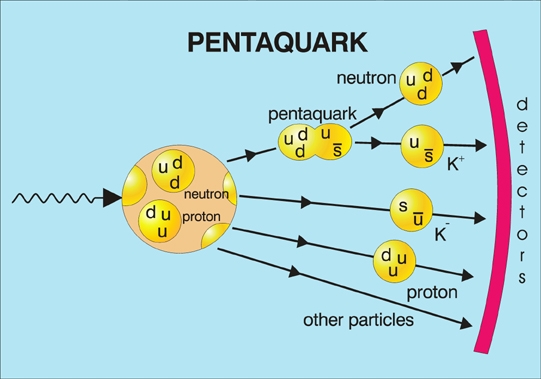
The production of a pentaquark through the absorption of a gamma ray (wiggly line) by a nucleus. The pentaquark decays so rapidly that it cannot be observed, so its existence must be inferred from observations of the gamma rays and of the K+ mesons that are produced when the pentaquark decays (image courtesy of Physics News Graphics, American Institute of Physics).
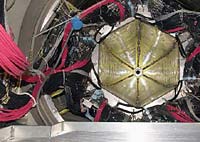
The K meson detector at Jefferson Lab (JLab), one of the labs where the pentaquark was observed (photo courtesy of Greg Adams, Jefferson Lab).
The pentaquark is produced by bombarding light nuclei with high energy gamma rays, as shown in the diagram. The pentaquark itself cannot be detected, since it lives only about 10-20 seconds before decaying into a neutron and a K+ meson (see upper right part of the diagram). Observations of the meson and the gamma rays established the presence of the pentaquark, and three additional experiments have confirmed this result.
This exotic new kind of particle has caused quite a stir in the physics world. As often happens, the discovery has raised interesting new questions, for it turns out that the very theory that led the experimentalists to their discovery does not predict all pentaquark properties correctly. A competing theory has already appeared, and since both theories predict as-yet-undiscovered particles, and with differing masses, future experiments may resolve this disagreement. In any case, it’s an exciting time in particle physics.
Links
Lawrence Berkeley National Lab
Stanford Linear Accelerator
The Exploratorium/CERN










